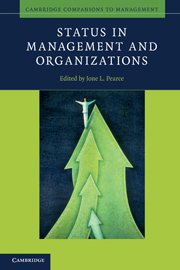Book contents
- Frontmatter
- Contents
- Figures
- Tables
- Contributors
- Foreword
- Preface
- 1 Introduction: The power of status
- Part I How status differences are legitimated
- Part II The influence of status on markets
- Part III The role of status in new industries and ventures
- Part IV When ascriptive status trumps achieved status in teams
- 8 Status cues and expertise assessment in groups
- 9 The malleability of race in organizational teams
- Part V Status in the workplace
- Part VI Developing status and management knowledge
- Index
- References
9 - The malleability of race in organizational teams
A theory of racial status activation
from Part IV - When ascriptive status trumps achieved status in teams
Published online by Cambridge University Press: 05 June 2012
- Frontmatter
- Contents
- Figures
- Tables
- Contributors
- Foreword
- Preface
- 1 Introduction: The power of status
- Part I How status differences are legitimated
- Part II The influence of status on markets
- Part III The role of status in new industries and ventures
- Part IV When ascriptive status trumps achieved status in teams
- 8 Status cues and expertise assessment in groups
- 9 The malleability of race in organizational teams
- Part V Status in the workplace
- Part VI Developing status and management knowledge
- Index
- References
Summary
In recent years, the heightened centrality of teams to the work of organizations has highlighted the critical importance of effectively and efficiently leveraging the human capital which resides within these organizational entities. However, the misspecification and underutilization of talent within teams remains widespread (Olivera and Argote, 1999; Wittenbaum and Stasser, 1996). These challenges to team functioning seem to be even more prevalent when demographic diversity is present (Mannix and Neale, 2005; Williams and O’Reilly, 1998). However, the increasing interdependence of demographically distinct individuals in the workplace necessitates that attention be devoted to understanding the specific ways in which demographic diversity impacts the ability of teams to leverage that knowledge which is collectively possessed across members. Specifically, we consider the circumstances under which the race/ethnicity of team members creates expectations about their ability to contribute to a group and become socially integrated. We focus specifically on those demographically distinct team members who already possess an existing reputation of achievement.
Drawing upon recent work that acknowledges the role status hierarchies play in obscuring the expertise possessed by team members (Bunderson, 2003; Thomas-Hunt and Phillips, 2004; Wittenbaum, 2000), diversity scholars have begun to apply a status lens as they consider the impact of demographic diversity on team dynamics. Such conceptualizations of demographic diversity argue that demographic characteristics are differentially valued and afford different levels of status to individuals within a team’s hierarchy (Sauer, Thomas-Hunt, and Morris, 2010). Status is the degree to which an individual or group is respected or admired by others (e.g., Ridgeway and Walker, 1995; Magee and Galinsky, 2008). Status tends to be derived from two types of characteristics: those that are ascribed and those that are achieved (Linton, 1936; Merton, 1968; Parsons, 1951).
- Type
- Chapter
- Information
- Status in Management and Organizations , pp. 238 - 266Publisher: Cambridge University PressPrint publication year: 2010
References
- 2
- Cited by



